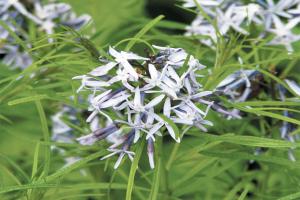A pretty nifty native plant is the Arkansas Blue Star
Winter is for pondering. Did you ever wonder why we pronounce Arkansas as “Ark an saw” and Kansas as “Kan sass”?
They are spelled so similar and pronounced so differently. It's because the French named Arkansas, and in French the final 's' is silent, and the English named Kansas, and in English we pronounce the final ‘s.’
And Arkansas, with the silent s, brings us a pretty nifty native plant, the Arkansas Blue Star (Amsonia hubrichtii), often just called Amsonia. This hardy native blooms in late spring through early summer with loose clusters of blue, star-shaped flowers. But it is the lacy, willow-like foliage that is the secret to amsonia's beauty. The light-green foliage changes to glowing, deep golden-yellow every autumn. This bright yellow color can last well into winter. These easy-to-grow plants will reach up to three feet tall with an equally wide spread. Amsonia attracts butterflies and other pollinators.
Plant amsonia in full sun to partial shade. If your planting site is wet, place the plants in full sun; otherwise they do well in light shade. Organic mulch such as grass clippings or leaves cuts down on water evaporation, and the mulch breaks down into compost to feed the soil. Don't be discouraged if the plants look a little scrawny at first; it may take a few years for them to really fill out.
After the flowers die back in summer, add some slow-release organic plant food or compost to each plant.
Do not let the soil dry out, especially if they are planted in full sun. As with all plants, it is best to water deep and slow, but don't let the soil get too soggy. You won't need to water once the cooler fall weather arrives. Plants are available at many nurseries, but be sure to ask by its scientific name, Amsonia hubrichtii. You can also order plants by mail from specialty nurseries such as White Flower Farm (www.whiteflowerfarm.com).
The plants contain a bitter, milky sap that deters deer but may also cause skin rashes, so wear gloves when pruning or cutting Arkansas Blue Star flowers.
You can propagate amsonia by sowing seeds in early spring or autumn. You can also simply divide existing clumps in the spring. To root cuttings, take softwood cuttings in early summer and root them in pots before transplanting into the garden.
About the only real problem facing amsonia is plant rust. To help avoid rust, keep plants spaced far enough apart for good air circulation.
Try planting clumps along a flower border or in more informal settings such as a cottage garden, along the edge of a woods or mixed with other grasses. The light-blue flowers mix well with almost every other flower color. The light-green foliage makes a striking contrast to any dark-leaved plants such as elderberry. You can use its informal bushy shape to fill in around larger shrubs.
The fine, feathery texture and bold yellow fall color blend seamlessly with fall-blooming purple coneflowers, autumn crocus, asters, sedum Autumn Joy, and chrysanthemums. In short, the Arkansas Blue Star flower is worth all the corn in Kansas (or Arkansas). You choose.




















































